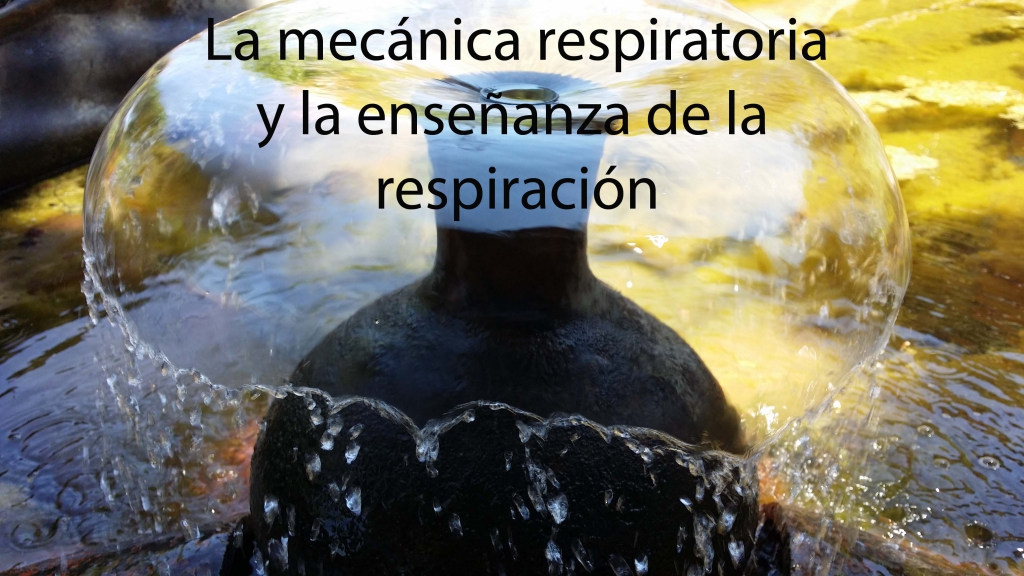THE MECHANICS AND TEACHING OF BREATHING
There exists a great variety of fields and professionals, who use breathing as fundamental tool in their work. In the last five decades, research projects about breathing in western countries have focused on lungs’ diseases or illnesses of the breathing apparatus, rather than on the mechanics of breathing, on the interactions between the psychological and physiological aspects of the breathing mechanics, or on the spiritual aspect of breathing.
For thousands of years in the east, research in the field of the science of breathing has been carried out and implemented. But in the last decades, this research has increased in psychotherapy, in psycho-spiritual development practices, and in breathing mechanics.
The disciplines in which breathing is present as fundamental tool are manifold and varied in their objectives: diagnosis and treatment; physical, emotional, psychological and spiritual health; different fields that use breathing as therapy with diverse ways of applying it in order to reach states of expanded awareness.
Professionals employing breathing as main tool in their work speak about physical, emotional, psychological, spiritual healing. Nevertheless, very few of them have conducted sufficient analyses about the “bellows” of the breathing mechanics, namely, the way the body expands and contracts, especially the trunk on the levels of its three rings – lumbar-abdominal, diaphragmatic and costoclavicular – during the in-breath and out-breath. Just a few professionals use breathing as fundamental means, or consider and work on the mechanics of ventilation at the diagnosis and treatment level; and rare are those professionals who employ the psychological diagnosis in their field of exploration.
What does “correct breathing” mean? It means to breathe naturally, to breathe the way the mechanics of the breathing function is designed for, free from psychological somatizations: namely, the complete breathing should occur at the three levels of the trunk’s rings, expanding at the same time without rising. It can be attained by keeping the trunk relaxed and leading the inhalation toward the lumbar zone. In this way, breathing is not superficial, but deep, prolonged, rhythmic, relaxed, enjoyed. Certainly, we have to consider the front and the back of the neck ring, as well as the oral and ocular rings, all kept free
from restrictions in order to achieve as much as possible a natural and correct breathing. We are neither speaking about the preference or correctness of breathing through the nose or the mouth, nor about calculating the timing of the breathing process, but we are concerned with the expansive and contracting – or implosive – movement of the breathing pump.
Although significant, it is not the fundamental aspect of breathing: in breathing, it is important to fill the lungs in all parts of their lobes. One can achieve it with a sufficient going down of the diaphragm, especially in the back, and keeping the rib cage relaxed. In this way, it can expand thanks to the pressure void produced by the diaphragm when going down, and thanks to the action of the in-breathing muscles.
There are many breathing techniques in different eastern and western traditions, but the essential, basic, fundamental aspect is that these breathing techniques work with a proper and natural mechanics of ventilation. Generally, people speaking about learning how to breathe do not refer to the exploration of the breathing mechanics and to the analysis of its dynamic functioning. They mainly speak about other aspects such as the timing of breathing, apnea and out-breath, about breathing through the nose, swelling the belly without expanding the thorax, or expanding the thorax while withdrawing the belly. Moreover, people normally speak about the complete breathing without remarking that the trunk has to expand.
They even point out different types of pranayama, without being concerned about the explanation of the breathing pump and its proper way of working. Breathing through the mouth is supposed to help reach certain catalyzing effects, or breathing through the nose is used to obtain euphoric states, etc. Besides, people speak about being aware of one’s own breathing and one’s own body at the same time, or about breathing deeply and slowly making the lowest noise possible, while other people are concerned with posture. Nevertheless, just a few people refer to the analysis of the expanding and contracting movement of breathing, namely, the breathing mechanics.
There is great confusion among people who teach how to breathe, and no scientific field is as confused as the science of breathing. Some people teach improper breathing and show a way of breathing which goes against the natural and free working of the ventilation mechanics in its anatomic and physiological function. Some bad practices taught by those people are swelling the belly until obtaining a round belly without expanding the thorax, or expanding the thorax while withdrawing the belly. This is incorrect when not considered as punctual and isolated practice for a specific goal, but as normal and ordinary breathing. One needs to give his/her own body the freedom it deserves, keeping it free from tense muscular structures, which reduce the free movement of the ventilation pump.
Different fields in which breathing is fundamental. Breathing as catharsis. Hyperventilation, body and subconscious.The hyperoxemia – high doses of oxygen in the body – works as catalyzer, leading to the emergence of traumas to the surface of consciousness. These traumas are present in the psychological and physical subconscious. Each body part is considered as an emotional cartographic puzzle, telling its own biographical story. Professionals apply breathing to psychotherapy for catharsis processes, in therapeutic methods such as Holotropic Breathing, Holorenic Breathing, Rebirdhing, Bioenergetic, Vegetotherapy, etc.
They use breathing as means for catharsis, either from the perspective of grace, or from the perspective of beauty. Through grace, which is the awareness of the negative characteristics of personality – the chapapote – , the process is volcanic, emotional, clear, it is fire of passion, a state of contraction, and in this process psycho-emotional conflicts and traumas are released. They are toxic codes that make people sick and do not allow them to breathe life the way they wish. At the end of this volcanic process, the state of inner peace or oceanic feeling emerges, as soon as one gets rid of the weeds covering his/her diamond. This final phase is similar to the catharsis from the perspective of beauty.
The other process that can occur, once the working session has begun, is the beauty’s process, which means to position oneself in the manifold facets of the diamond, positive qualities and virtues. In this alchemy, the process of catharsis comes from “the fine”. Here a person can enter a state of expansion, tenderness, a certain degree of trance or ecstasy, contemplating the polyhedral facets of the brilliant diamond. From this space of protection and security, one can contemplate as well the negative personality traits, or chapapote, but from a different point of view, which can be even more efficient.
These processes are different, even opposite to each other, although they have similar aspects. Either one can emerge during the process that presents breathing as fundamental tool.
These two modalities can appear in the catharsis process, even though the volcanic passion’s way of the ontic darkness most commonly occurs, while less frequent is the way of the diamond’s subtle and numinous beauty, in a state of expanded consciousness.
The expert of breathing could foster these two ways, even if catharsis coming from the numinous diamond is more difficult to stimulate.
When a person has many problems and allows himself/herself to enter a catharsis, which with no doubts will be the volcanic one, he/she will have to release the toxic inner fire in order to create a paradise in the volcanic hollow.

